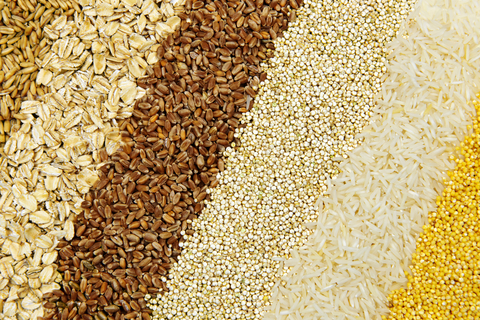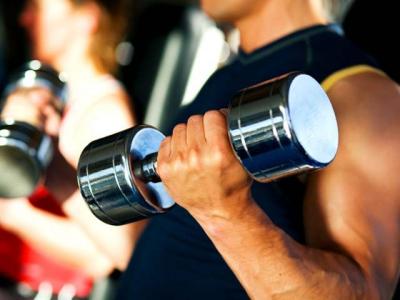4 Tips for Fitting in Exercise
Wake up with a 10-minute workout: Nothing saves time more than a workout at home, so start your day with a total-body 10-minute workout — you’ll burn calories, raise your heartbeat, and tone all over before you even have to take a shower. You don’t even have to spend time making up your own circuit.
While you’re waiting: Waiting in line is inevitable, so don’t let all that time go to waste. Do a few of these discreet toning moves to continue to whip your body into shape while you wait.
Lunchtime workout: Your day may be packed, but sometimes that’s just the time to duck into your gym for a quick workout. A midday workout can re-energize and refocus your mind, making you more efficient at performing afternoon tasks (and possibly freeing up your time!). To find out how to get in and out of the gym without delay, read our time-saving tips for fitting in a midday workout.
Relax and unwind: Keeping your muscles loose and flexible is key to an effective workout routine. Add a few of these sleep-inducing yoga poses before you go to bed in order to tone your muscles while relaxing your body and preparing yourself for bedtime.
Maximize your Gains
After a couple of months squatting you probably increased how much you can lift. However, after the initial spike, some people can’t maintain the rate of strength gains you experienced in the beginning. Even worse, you now may be experiencing nagging joint pains.
When you lift weights you are putting your muscles and soft tissue – ligaments, tendons and fascia – under a mechanical load that will make them grow. For this to happen, protein breakdown and collagen degradation should occur first, followed by a greater protein synthesis and collagen turnover to support the changes.
At the gym, you’re basically breaking down the muscles and surrounding tissue. At rest is when adaptation occurs. This is what makes resting and eating the right food – particularly before and after exercise – such a critical part of an exercise program.
Eat Watercress for better Workout Results
 I’ve worked with professional athletes in numerous sports, so I’m always on the lookout for new research on foods and nutrients with performance and recovery benefits. The latest to pop up is watercress. A study published in the British Journalof Nutrition reports that eating a small amount of this leafy green each day raised levels of key antioxidants that fend of damage caused by exercise.
I’ve worked with professional athletes in numerous sports, so I’m always on the lookout for new research on foods and nutrients with performance and recovery benefits. The latest to pop up is watercress. A study published in the British Journalof Nutrition reports that eating a small amount of this leafy green each day raised levels of key antioxidants that fend of damage caused by exercise.
As a board certified sports RD, I often explain to my clients that while exercise is necessary for seeing results in strength, endurance, and bodycomposition, it also takes a toll on the body. The wear and tear and increased demand can create more free radicals, nasty substances that contribute to DNA damage. That’s why a nutrient-rich diet that neutralizes free radicals and allows the body to heal goes hand in hand with training.
In this particular study, ten healthy young men were given a small bag of watercress, about 3 ounces, daily for eight weeks. The participants were then asked to execute treadmill workouts that included short bursts of intense exercise. Another group, which was not given watercress also performed the treadmill workout after eight-week as a control.
Good fats in moderation can be good for you
For years, you probably heard that fats were bad for you and carboydrates (“carbs” were good. That is wrong. We all need both fats and carbs in our diet. There are no proven health benefits, in general, from substituting carbs for fats.
What we need to pay attention to is eating primarily “good fats” and “good carbs,” and minimizing “bad fats” and “bad carbs” — and not eating too much even of the good fats and carbs. Calories still do matter.
So what are the bad fats and the good fats?
Saturated fats and trans fats are bad fats. They boost your chances of developing heart disease by increasing your blood levels of LDL (bad) cholesterol and triglycerides.
Trans fats are even worse — they also reduce your good HDL cholesterol. Cutting back on saturated and trans fats can help prevent and control heart disease.
Saturated fats are found mainly in meat and whole-fat dairy foods. Limit red meat, particularly processed meat, and full-fat dairy products such as butter, cheese and ice cream. Choose non-fat or low-fat dairy products and lean cuts of meat.
Trans fats are found in margarine, particularly hard stick margarine, commercially baked goods like cookies and crackers, and in many fried foods.
There is no safe level of trans fats, and you should eat as little of them as possible. To do so, avoid packaged foods where the package label says they contain “partially hydrogenated” oils, and look for the amount of trans fats on the Nutrition Facts panel.
The good fats are polyunsaturated and monounsaturated fats. Good fats can help lower LDL (bad) cholesterol and prevent heart disease.
Oatmeal nutrition facts
Is oatmeal truly beneficial for reducing cholesterol and keeping our hearts healthy? Let’s review some oatmeal nutrition facts to get the real scoop.
-
150 calories
-
30 grams of carbohydrates
-
8 grams of fiber
-
11 grams of protein
-
5 grams of fat (1 gram saturated)
-
20 percent daily value (DV) of iron
-
30 percent DV of magnesium
-
33 percent DV of phosphorous
-
33 percent DV of selenium
-
20 percent DV of copper
-
150 percent DV of manganese
Get a Beach Body in 3 Short Months
 If you want to unveil a chiseled physique, or at least one that’s svelter at the beach this summer, you’re going to need a game plan. Luckily, one has been provided for you and it requires no more than three weekly trips to your local gym — spending no more than an hour there each session, and a ton of dedication and intestinal fortitude.
If you want to unveil a chiseled physique, or at least one that’s svelter at the beach this summer, you’re going to need a game plan. Luckily, one has been provided for you and it requires no more than three weekly trips to your local gym — spending no more than an hour there each session, and a ton of dedication and intestinal fortitude.
The cornerstone movements
Seven movements, performed over the course of your three weekly workouts, will provide you an ample muscle building, fat incinerating stimulus.
Barbell Front Squat
Popularized by bodybuilders and used by Olympic weightlifters as an assistance exercise to the Clean and Jerk event, front squats target the quadriceps, while not beating up the shoulders and low back nearly as much as the back squat.
How to Front Squat
With an Olympic bar situated in a power rack at chest height, walk up to it, grasp it firmly, keeping a shoulder width, and pull the elbows up and through the bar. Get the core tight and take one step back with your dominant foot. Bring your non dominant foot back, meeting your dominant foot, maintaining a shoulder to hip width stance. Deeply inhale, keeping the core tight and shoot your hips rearward. Keep the upper back tight with the elbows up the entire time. Hold in the bottom for a split second before ascending. On the ascension, sit up by extending the hips and keeping the shoulders high. Remember to exhale. Get reset at the top and repeat.
Barbell Deadlift
Few exercises allow you to handle as much weight, nor deliver the growth hormone releasing effects of the deadlift. A staple in the routines of professional and collegiate athletes, bodybuilders, and strongman competitors, is probably the most demanding, yet rewarding movement of them all. Vast numbers of motor units in muscles are dispatched to assist in moving the weight, as is a connecting series of joints, including the hips, knees, shoulders, and ankles. All must work in unison to get the bar from the floor to waist height. It’s no wonder that deadlifts are among one of the elite total body strength exercises.
How to Deadlift
Assume a shoulder to hip width foot stance with an Olympic bar positioned directly over the mid foot. Shoot the hips back and down, away from the bar, while keeping your shoulders back. Grasp the bar with a double overhand grip, slightly outside of the knees. Brace the core, keeping the lower back arched (not rounded) slightly. Get the shoulders over the bar and higher than the hips. Drive through the heels to extend the hips and push the chest through, keeping the shoulders back. Your knees will extend as the bar passes them. Focus on pulling the bar back into to you, not up, as wrongly suggested by many trainers and coaches.
Overhead Press
The overhead press is one of those exercises that is commonly avoided by casual gym goers as it’s wrongly implicated in back and shoulder injuries. However, the majority of the people suffering from these injuries either don’t know how to perform an overhead press properly, or they’re using loads that are too great for their shoulder girdle and low back to handle.
How to Overhead Press
To overhead press correctly, you must position the bar in a power rack, approximately at chest height. With a slightly wider than shoulder-width grip, grasp the bar firmly, while retracting your shoulder blades and bracing the core. Keep the elbows close to the body and perpendicular with the floor. Unrack the bar, step back, keeping the feet positioned at feet to shoulder width and drive the elbows straight up. As the bar passes your face, pull the head through, so your ears are directly positioned beneath the bar with the elbows fully locked out. Doing so will reduce the amount of strain placed upon the shoulders.
Loaded Carry
There’s nothing more badass than picking up a pair of your gym’s heaviest dumbbells and taking a walk with them. However, there are a few caveats. In order to not injure yourself and to derive full benefits from this exercise, you must firmly grip the dumbbells, while keeping the head up and shoulders back. Keep the core tight and take deliberate, yet controlled steps. Keep the elbows locked out, as flexing them, will only tax your biceps and upper back, and tire your forearms even more. Walk for as long as possible before your form breaks down.
Pull Up
Pull ups have seemingly disappeared from the routines of many gym-goers and seeing them properly performed are rarer than holiday bonuses these days. Strength coach Todd Bumgardner, author of the Pull Up Manifesto, dubs them the “king of upper body exercises” and they are for great reason. Few exercises challenge the grip and require the fluid interaction of the core, shoulder girdle, elbows, and wrists as much as the pull-ups. They’re great for those desiring healthy shoulders, as they strengthen the scapulothoracic muscles — muscles which extend the thoracic spine and retract and depress the shoulder blades.
Pull Up Performance Cues
Hanging from a pull up bar with a fully clenched grip, in which the thumbs are wrapped around the bar, tighten the core, shoot the shoulder blades back and down — tucking them close to the spine and drive the elbows through the body. Don’t pull yourself to the bar with your arms, focus on driving the elbows back and behind you. Doing so, will activate the musculature of the upper back, giving you more firepower to complete the movement, and lessen the load on the elbow and wrist flexors. Altering your grip, even slightly, will vary the demand on different muscles. Flipping the grip with your palms facing you will hit the biceps harder. Keeping the palms facing each other will hit the trapezius and forearms harder and turning the palms away from your body will target the lats and rhomboids more.
Sprinting
Unplug your steady state workouts on the treadmill and hit the track, or field, or parking lot instead. Work up to performing shorter distance sprints, following a series of tempo sprints. Start at a distance of 20 yards or shorter, focusing on your burst, before going longer. Eventually you’ll work yourself up to distances around 100 yards, or meters, which will really challenge you. Be sure to incorporate adequate rest periods between your sprinting bouts. Ideally a work to rest ratio of 1:10 is ideal. For example, if it takes you 0:15 seconds to cover 100 yards, or meters, take 150 seconds, or 2:30 to rest. Active recovery in the form of walking, or light jogging, or a dynamic warm-up influenced movement, such as a lunge, or high knees, and hopping, will burn even more calories as it will keep the heart rate jacked up the entire time.
Jumping
Hundreds of books have been devoted to plyometric exercise, so we’ll keep it brief here. Take a gander at the physiques of football and basketball players the next time you watch a game and you’ll notice how explosively they jump, cut, and change directions. Although many pros are genetically elite, they jump higher and cut faster due to plyometric training. A beginner’s movement is the box jump, which teaches you to land as softly as possible after completing a jump of 2 to 3 feet high.
Grab a plyo box, bench, or sturdy table, or desk, ranging from knee to waist height with a surface that is large enough to land on. A surface that is at least 30” x 30” is ideal. Jump up and onto the surface, upon landing tighten up through the core, shoot the hips back and down and keep the shoulders directly over the knees, which will be slightly flexed. Remember to land as softly as possible. As box jumps get easier, progress to a box, or surface of a greater height, or move onto jump squats or vertical jumps.
For jumps squats, interlace your fingers behind your head and descend into a squat position, as you ascend, shoot the hips up quickly and jump as high as you can. Land in a quarter squat, again shooting the hips back and down, with the shoulders in line with the knees.
Once you’ve mastered jump squats, try jumping as high as you can. Reach for the sky at the top of the jump like you’re an invitee at this year’s NFL combine. If you have a basketball rim handy, aim for the rim. If you’re shorter, or aren’t that athletic shoot for the bottom of the net.
Sample Week
| Day One | Day Two | Day Three |
| Box Jumps 5 sets x 5 repetitions | Box Jumps 5 sets x 5 repetitions | Box Jumps 5 sets x 5 repetitions |
| Barbell Front Squat 4 x 12 | Pull Up 4 sets | Barbell Deadlift 4 x 5 |
| Barbell Overhead Press 3 x 10 | Push Up 3 sets | Leg Press 3 x 12 |
| Barbell Shrug 3 x 12 | Bodyweight Lunge 2 sets | Dumbbell Bench Press 3 x 12 |
| Lying Leg Curl 2 x 12 | Dumbbell Curl 2 sets | Cable Row 3 x 12 |
| Calf Raise 2 x 15 | Plank alternated with Crunch 3 seats each | Hanging Leg Raise 2 sets |
| Finisher: Loaded Carry 2 x 30 yards | Finisher: Sprint (work up to 2 40 yd sprints) | Finisher: Bodyweight Lunge 100 yards (take rest during lunge if needed) |
Study Finds a Protein Combination (Soy, Whey, Casein) is Best to Consume Post-Workout for Building Muscle

Today at Experimental Biology 2012, Dr. Blake Rasmussen and colleagues presented a new and first-of-its-kind clinical study: “Effect of Protein Blend vs. Whey Protein Ingestion on Muscle Protein Synthesis Following Resistance Exercise.” The results of this study suggest that a protein blend (combination of soy, whey and casein) may be best to consume post-workout for building muscle. Specifically, the blend of proteins in this study showed an increase in a person’s “anabolic window” (the amount of time it takes for building muscle to occur post exercise).
“This study confirms that consuming a blend of proteins (soy, whey and casein) versus whey protein alone provides a prolonged delivery of amino acids to the muscles, making it optimal for consumption following resistance exercise,” said Dr. Rasmussen, professor and interim chair of the Department of Nutrition & Metabolism at the University of Texas Medical Branch and the senior author of this study. “The results of this study are critical for sports nutrition consumers and regularly active individuals.”
The protein in the blend used in this study consisted of 25 percent isolated soy protein, 25 percent isolated whey protein and 50 percent casein. This combination of protein blends was determined in a preclinical study, of which was presented at Experimental Biology 2011.
Soy, whey and casein proteins are all absorbed at different rates during digestion. Whey protein is referred to as a “fast” protein because it is rapidly absorbed whereas casein, a “slow” protein, requires several hours to be digested. The ability of soy protein to deliver amino acids is “intermediate,” meaning concentrations in blood peak somewhat later compared to whey, but its digestion rate is much quicker than casein. Hence, the effect of all three of these proteins combined appears to provide the extended release of amino acid delivery to the muscles.
“Your muscles don’t recover in 30 minutes. It takes at least 24-48 hours for your muscles to recover after a resistance exercise,” said Greg Paul, global marketing director for sports nutrition and weight management, Solae. “This study showed that protein blends can provide amino acid delivery for up to five hours, meaning if you consume a product or protein shake with these blends, the prolonged effect will deliver essential amino acids to feed your muscles until your next meal.”
David Beckham’s Workout Routine

WEEK 1
Beckham’s Workout
5-minute run
Intensity: 85% MHR
Rest: 4 minutes
Sets: 3
Your Challenge
5-minute run
Intensity: 75% MHR
Rest: Until your heart rate is 60% of your MHR
Sets: As many runs as you can do in 30 minutes
WEEK 2
Beckham’s Workout
2-minute run
Intensity: 90% MHR
Rest: 2 minutes
Sets: 7
Your Challenge
3-minute run
Intensity: 90% MHR
Rest: Until your heart rate is 60% of your MHR
Sets: As many as you can do in 20 minutes
WEEK 3
Beckham’s Workout
1-minute run
Intensity: 95% MHR
Rest: 1 minute
Sets: 15
Your Challenge
1-minute run
Intensity: 85% MHR
Rest: 1 minute
Sets: 5 or 6
WEEK 4
Beckham’s Workout
60-yard turnarounds (sprint 60 yards, turn around, and sprint back)
Intensity: 20 seconds total per out-and-back sprint
Rest: 1 minute
Sets: 8 to 10
Your Challenge
60-yard turnarounds (sprint 60 yards, turn around, and sprint back)
Intensity: 30 seconds per sprint
Rest: 2 1/2 minutes
Sets: 3 or 4
WEEK 5
Beckham’s Workout
60-yard sprint
Intensity: As hard as possible
Rest: 10 seconds
Sets: 8 to 10
Your Challenge
60-yard sprint
Intensity: As hard as you can
Rest: 20 seconds
Sets: 3 or 4
Post-Workout Protein
You may already know that you should have a protein-rich snack after exercising, but are you actually getting the right kind to stimulate muscle growth? A new study from the University of Texas Medical Branch finds that eating a mix of protein types—whey, casein and soy—right after your workout may help you get bigger than just a single type of protein alone.
That’s because the combo of the three proteins seems to prolong the body’s amino acid (protein) delivery to muscles, increasing the amount of time that your pecks, lats and delts are in their “growth state.” This happens because different forms of protein get absorbed by the body at different rates, researchers say. Soy is considered an “intermediate” deliverer of amino acids, whey is a “fast” protein and casein is a “slow” protein, taking a few hours to digest.
The longer you can supply the muscle with amino acids, the better it is for growth and recovery, says Mark Cope, nutrition research scientist at Solae Global, the consumer goods company that founded the study. Since muscles need a full day or two to recover after strength training (not just 60 minutes), combining whey with soy and casein delivers a more balanced amino acid profile and provides a prolonged delivery of critical nutrients to the muscle.
Not sure how to get this mass-maximizing combo without eating three different snacks? Look for ready-made protein smoothies, bars and products (like MHP’s Power Pak Pudding and PowerBar’s ProteinPlus Bites) that have a combination of whey and soy protein. You can also make your own post-workout protein snack by mixing milk (that’s where you’ll find casein), soy and whey powders, along with fruit and ice.
The Secret to Stronger Muscles
 One look at Olympic weight-lifters shows that the heavier the weights, the stronger the weight lift, right? Although there’s definitely some truth to this conventional workout wisdom, a new position paper published in the journalApplied Physiology, Nutrition, and Metabolism argues that there’s more to the story.
One look at Olympic weight-lifters shows that the heavier the weights, the stronger the weight lift, right? Although there’s definitely some truth to this conventional workout wisdom, a new position paper published in the journalApplied Physiology, Nutrition, and Metabolism argues that there’s more to the story.
Weight training with less weight but more repetition may be as effective for building muscle as lifting heavier weights for fewer repetitions, said researchers at McMaster University in Ontario. The key to muscle gain, researchers say, is working the muscles to the point of fatigue, no matter the weight size. They want you to feel the burn.
The authors of the paper conducted a series of experiments to measure how muscles react to different forms of training. They found, not surprisingly, that high-intensity muscle contractions from lifting heavy weights produced muscle development. But when volunteers performed resistance training with smaller weights until they reached muscle fatigue, identical muscle development was formed. The higher repetitions also helped sustain the muscle-building response in the days following the workout.
This means you can continue using 3-pound hand weights for bicep curls if you want. But if you want to see a bigger, stronger bicep, you must keep up the curls until you have to fight to pull up the weight each time. (For a woman who works out regularly, this could means scores of repetitions.)
No matter how you chose to get there, the key to seeing a real benefit from strength training is using enough weight to challenge yourself, and repeating the exercises enough times that your muscles reach fatigue. As you get stronger, remember to switch to progressively heavier weights to keep on feeling the burn.


